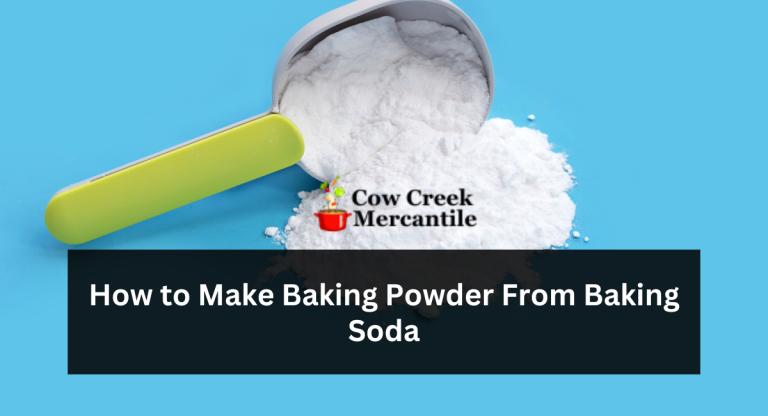In the captivating realm of baking, a small amount of this and a small amount of that can have a significant impact. Baking powder, a dependable leavening agent that aids in producing fluffy cakes and airy pastries that are popular with many people, is one of the essential ingredients found in every baker’s cabinet.
But what occurs when you’re in the middle of a baking endeavor only to learn that your reliable container of baking powder is devoid of contents? Do not worry, since today we are going to reveal a lesser-known technique that can be helpful: how to create baking powder using baking soda.
During this exploration of baking chemistry, we will investigate how baking soda is transformed into baking powder, revealing the scientific principles behind this impressive culinary process. Whether you have experience in baking or are just starting out, this information is a wonderful asset for your cooking skills.
So, let’s start this interesting journey and learn how to make homemade baking powder from baking soda.
The Function of Leavening Agents in Baking:
Before we get into the process of converting baking soda into baking powder, let’s pause for a moment to grasp the important function of leavening agents in baking. Leavening agents play a crucial role in creating the fluffy texture of our beloved baked goods.
They create their effect by releasing carbon dioxide gas when combined with specific ingredients, resulting in the formation of those attractive bubbles and giving our delicacies a light and fluffy texture.
Baking Soda versus Baking Powder:
In order to understand the transformation from baking soda to baking powder, it is important to distinguish between the two types of leavening agents.
Baking Soda:
Also called sodium bicarbonate, baking soda is a pure chemical molecule. An acid and a liquid are necessary to activate its leavening effects. When combined with an acidic substance (such as yogurt or vinegar) and a liquid (like milk), baking soda generates carbon dioxide gas, which results in the expansion of your batter or dough.
Baking Powder:
In contrast, baking powder includes an acid (usually cream of tartar) and a base (often baking soda), as well as a starch to prevent clumping. Baking powder is classified as a “double-acting” leavening agent since it releases carbon dioxide gas two times—first when combined with wet ingredients and then when subjected to heat when baking.
Ingredients for DIY Baking Powder:
Now, let’s reveal the hidden recipe for creating your own baking powder at home. You will just require three basic ingredients:
Baking Soda:
This is the main ingredient in our metamorphosis.
Cream of Tartar:
A dry, granular acid that can activate the baking soda.
Cornstarch (if desired):
Cornstarch is commonly included in commercial baking powder to avoid clumping. Its inclusion is completely voluntary, although it can assist in maintaining the smoothness of your homemade version.
The Transformation Trick:
Making your own baking powder at home is as simple as counting 1-2-3. Here is a basic equation to adhere to:
1 portion baking soda + 2 portions cream of tartar = DIY Baking Powder
For example, if you require one teaspoon of baking powder, you will combine 1/4 teaspoon baking soda and 1/2 teaspoon cream of tartar. If you need a greater amount, just adjust these measurements accordingly.
Additional Step: Include Cornstarch
To replicate the texture and characteristics of store-bought baking powder, you can use cornstarch. Add 1/4 teaspoon of cornstarch for every teaspoon of baking powder. This aids in preserving a uniform texture and avoids the formation of lumps.
Combining and Keeping:
To make your own baking powder, mix together the baking soda, cream of tartar, and cornstarch (if desired) in a small bowl. Make sure the mixture is thoroughly mixed to ensure even leavening in your recipes.
After combining the ingredients, you can use your homemade baking powder right once or save it in a sealed container for later use. This homemade version retains its effectiveness much like the kind you may buy in a store.
Advice for Achieving Success in Baking using Homemade Baking Powder:
Now that you’ve become skilled at creating baking powder from baking soda, let’s examine some suggestions to guarantee that your baking projects are highly successful:
1. Freshness is important:
Baking soda and cream of tartar may lose their effectiveness with time. In order to achieve optimal outcomes, utilize ingredients that are fresh.
2. Blend Well:
When adding your homemade baking powder to the dry ingredients, ensure that it is evenly mixed to provide even leavening.
3. Don’t Wait:
After you’ve mixed your dry and wet ingredients in a recipe that requires baking powder, it’s recommended to start baking right away. The dual-functionality of store-bought baking powder provides some additional versatility, whereas with homemade baking powder, timing is crucial.
4. Storage:
Store your homemade baking powder in a sealed container in a cold, dry location to preserve its potency.
Conclusion:
In the wonderful world of baking, understanding how to create baking powder from baking soda is like possessing a hidden formula that can save your cooking creations when necessary.
By using a small number of basic components and some understanding, you can make sure that the absence of baking powder never obstructs your baking experience. Therefore, equipped with this newly acquired knowledge, go ahead and embrace the wonders of homemade baking powder, creating your culinary creations with assurance and imagination.
The captivating realm of baking awaits, where every recipe is an opportunity to create happiness and pleasure in your oven!

